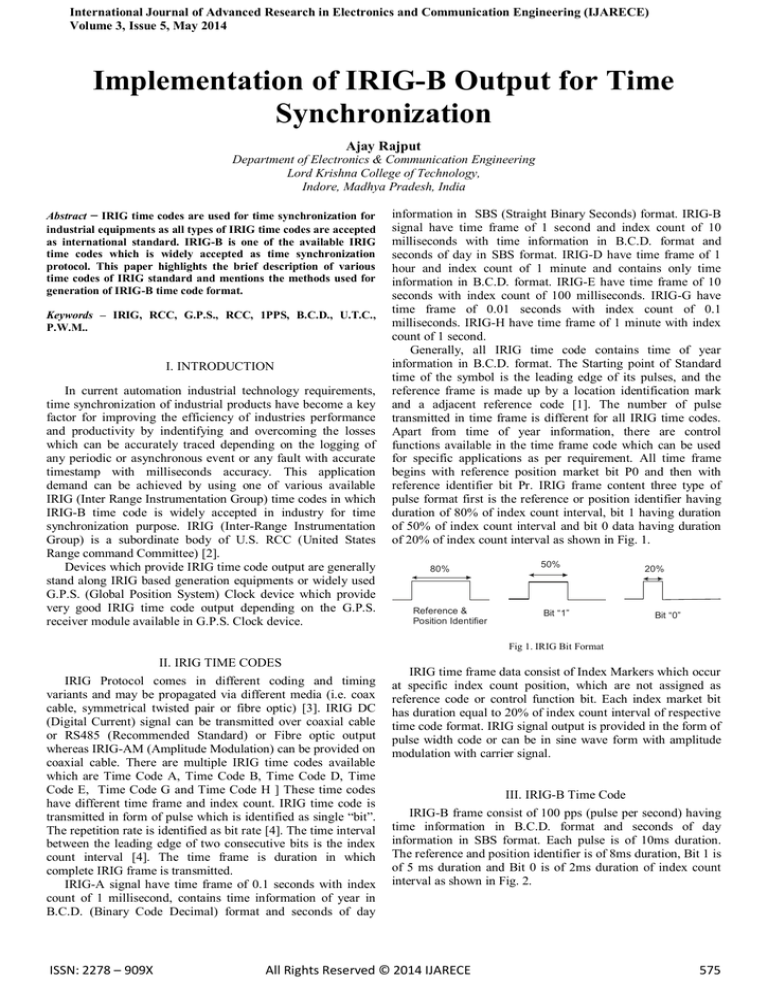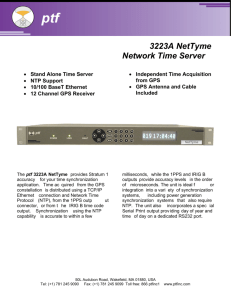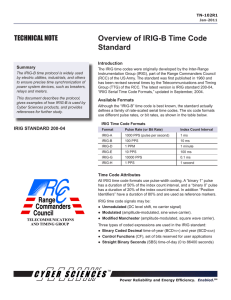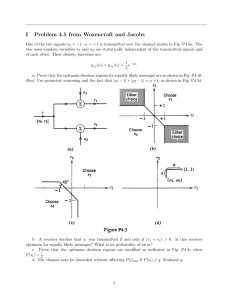
International Journal of Advanced Research in Electronics and Communication Engineering (IJARECE)
Volume 3, Issue 5, May 2014
Implementation of IRIG-B Output for Time
Synchronization
Ajay Rajput
Department of Electronics & Communication Engineering
Lord Krishna College of Technology,
Indore, Madhya Pradesh, India
Abstract – IRIG time codes are used for time synchronization for
industrial equipments as all types of IRIG time codes are accepted
as international standard. IRIG-B is one of the available IRIG
time codes which is widely accepted as time synchronization
protocol. This paper highlights the brief description of various
time codes of IRIG standard and mentions the methods used for
generation of IRIG-B time code format.
Keywords – IRIG, RCC, G.P.S., RCC, 1PPS, B.C.D., U.T.C.,
P.W.M..
I. INTRODUCTION
In current automation industrial technology requirements,
time synchronization of industrial products have become a key
factor for improving the efficiency of industries performance
and productivity by indentifying and overcoming the losses
which can be accurately traced depending on the logging of
any periodic or asynchronous event or any fault with accurate
timestamp with milliseconds accuracy. This application
demand can be achieved by using one of various available
IRIG (Inter Range Instrumentation Group) time codes in which
IRIG-B time code is widely accepted in industry for time
synchronization purpose. IRIG (Inter-Range Instrumentation
Group) is a subordinate body of U.S. RCC (United States
Range command Committee) [2].
Devices which provide IRIG time code output are generally
stand along IRIG based generation equipments or widely used
G.P.S. (Global Position System) Clock device which provide
very good IRIG time code output depending on the G.P.S.
receiver module available in G.P.S. Clock device.
information in SBS (Straight Binary Seconds) format. IRIG-B
signal have time frame of 1 second and index count of 10
milliseconds with time information in B.C.D. format and
seconds of day in SBS format. IRIG-D have time frame of 1
hour and index count of 1 minute and contains only time
information in B.C.D. format. IRIG-E have time frame of 10
seconds with index count of 100 milliseconds. IRIG-G have
time frame of 0.01 seconds with index count of 0.1
milliseconds. IRIG-H have time frame of 1 minute with index
count of 1 second.
Generally, all IRIG time code contains time of year
information in B.C.D. format. The Starting point of Standard
time of the symbol is the leading edge of its pulses, and the
reference frame is made up by a location identification mark
and a adjacent reference code [1]. The number of pulse
transmitted in time frame is different for all IRIG time codes.
Apart from time of year information, there are control
functions available in the time frame code which can be used
for specific applications as per requirement. All time frame
begins with reference position market bit P0 and then with
reference identifier bit Pr. IRIG frame content three type of
pulse format first is the reference or position identifier having
duration of 80% of index count interval, bit 1 having duration
of 50% of index count interval and bit 0 data having duration
of 20% of index count interval as shown in Fig. 1.
80%
Reference &
Position Identifier
50%
Bit “1”
20%
Bit “0”
Fig 1. IRIG Bit Format
II. IRIG TIME CODES
IRIG Protocol comes in different coding and timing
variants and may be propagated via different media (i.e. coax
cable, symmetrical twisted pair or fibre optic) [3]. IRIG DC
(Digital Current) signal can be transmitted over coaxial cable
or RS485 (Recommended Standard) or Fibre optic output
whereas IRIG-AM (Amplitude Modulation) can be provided on
coaxial cable. There are multiple IRIG time codes available
which are Time Code A, Time Code B, Time Code D, Time
Code E, Time Code G and Time Code H ] These time codes
have different time frame and index count. IRIG time code is
transmitted in form of pulse which is identified as single “bit”.
The repetition rate is identified as bit rate [4]. The time interval
between the leading edge of two consecutive bits is the index
count interval [4]. The time frame is duration in which
complete IRIG frame is transmitted.
IRIG-A signal have time frame of 0.1 seconds with index
count of 1 millisecond, contains time information of year in
B.C.D. (Binary Code Decimal) format and seconds of day
ISSN: 2278 – 909X
IRIG time frame data consist of Index Markers which occur
at specific index count position, which are not assigned as
reference code or control function bit. Each index market bit
has duration equal to 20% of index count interval of respective
time code format. IRIG signal output is provided in the form of
pulse width code or can be in sine wave form with amplitude
modulation with carrier signal.
III. IRIG-B Time Code
IRIG-B frame consist of 100 pps (pulse per second) having
time information in B.C.D. format and seconds of day
information in SBS format. Each pulse is of 10ms duration.
The reference and position identifier is of 8ms duration, Bit 1 is
of 5 ms duration and Bit 0 is of 2ms duration of index count
interval as shown in Fig. 2.
All Rights Reserved © 2014 IJARECE
575
International Journal of Advanced Research in Electronics and Communication Engineering (IJARECE)
Volume 3, Issue 5, May 2014
5ms
8ms
10ms
10ms
Reference &
Position Identifier
IV. Generation of IRIG-B120/122 Signal
2ms
10ms
Bit “1”
Bit “0”
Fig 2. IRIG-B Bit Format
IRIG-B frame further have multiple format in which IRIGB120 which is pulse width format and IRIG-B122 which is
amplitude modulated signal. This both the formats have time of
year information in B.C.D. format.
IRIG-B120/122 frame begins with position identifier and
reference identifier bits. Thereafter, 30 bits transmitted consists
of time of year information including seconds, minutes, hours
and days of year. IRIG-B122 signal is amplitude modulated
signal with carrier frequency of 1KHz signal. The mark to
space ratio is 3: 1 Vpp (voltage peak to peak) and the rising
edge of signal starts with 1PPS( One Pulse Per second) signal
at each second.
IRIG-B12x signal can be generated using microcontroller
using 1PPS signal, port pins of microcontroller with P.W.M.
(Pulse Width Modulation) capability and timers as per Fig. 3.
Microcontroller uses timer of 1ms which is calibrated at every
1PPS signal such that 1PPS is equal to 1000ms counts of timer.
This calibration is done continuously to ensure that 100pps of
IRIG-B signal is transmitted at every rising edge of 1PPS
signal. After the timer of 1ms is calibrated, the other timer is
started which can provide P.W.M. output of total period 1ms
pulse with minimum duty cycle of 20% and maximum duty
cycle of 80%. This P.W.M. based internal time is also
calibrated at every 1PPS signal. Now, after both the timers are
calibrated, time information is decoded in microcontroller and
provided in the IRIG-B frame depending on bit 1 or bit 0
information at specific location of seconds, minutes, hours,
days in IRIG-B120 frame. Data of time is shifted bit by bit intp
RIG-B frame at every 1ms interval. This data is transmitted at
every 1 ms P.W.M. timer based on 1PPS signal. The time
information in IRIG-B signal may be of U.T.C. (Universal
Time Coordinate) format or local time depending on the time
zone offset provided with respect to U.T.C. time.
IRIG-B120
1PPS
GPS
RECEIVER
MICROCONTROLLER
IRIG-B
TTL Pulse
IRIGIRIG
B122
AMPLITUDE
MODULATION 1KHz
Signal
SECTION
BUFFER
Serial
Time Frame
Fig. 3. IRIG-B120/122 Frame Generation
V. Test Results of IRIG-B
Below figures are the test results of IRIG-B120 (Fig. 4) and
IRIG-B122 (Fig. 5 and Fig. 6) signal captured on test
equipment.
Fig. 5. IRIG-B122 Output w.r.t. 1PPS signal
Fig. 4. IRIG-B120 Output w.r.t. 1PPS signal
ISSN: 2278 – 909X
All Rights Reserved © 2014 IJARECE
576
International Journal of Advanced Research in Electronics and Communication Engineering (IJARECE)
Volume 3, Issue 5, May 2014
Fig. 6. IRIG-B122 Output w.r.t. 1PPS signal
VI. CONCLUSIONS
The test results of IRIG-B120 and IRIG-B122 frame shows
full compliance with IRIG-B standards and were used to time
synchronization up to resolution of 1 millisecond for various
event recorders. This paper successfully represents the
generation and testing of IRIG-B signal. IRIG-B122 signal is
widely used in industrial equipments for time synchronization
purpose which can be transmitted over a considerable length of
few hundred meters. The number of equipments which can be
synchronized with a single IRIG-B122 signal depends on
current output capability of IRIG-B122 output.
ACKNOWLEDGMENT
The author acknowledges the references for valuable
suggestions on the paper and community of IRIG for providing
the valuable technical details for the subject.
REFERENCES
[1]
[2]
[3]
[4]
Li Ruisheng, Zhang keyuan and Feng Quifang “Solution Scheme of
G.P.S. Accurate time setting for Power system Automation Relay”, Vol
27, 1999, pp.31-32.
Guoping Zhou, Shaojun Qu and Yan xu, “The Decoding Device Design
of IRIG-B Format Time Code”, in Consumer Electronics,
Communications and Networks (CECNet), 2012 2 nd Internation
Conference, pp.3575-3578, April 2012.
P. Meinhardt, “Time Synchronized End to End Testing Using IRIG-B”,
in Developments in Power System Protection 2008. DPSP 2008. IET 9 th
International Conference, pp.611-614, March 2008.
IRIG Serial Time Code Formats, Telecommunications and Timing
Group, RCC (Range Commanders Council), Sept. 2004.
ISSN: 2278 – 909X
All Rights Reserved © 2014 IJARECE
577






